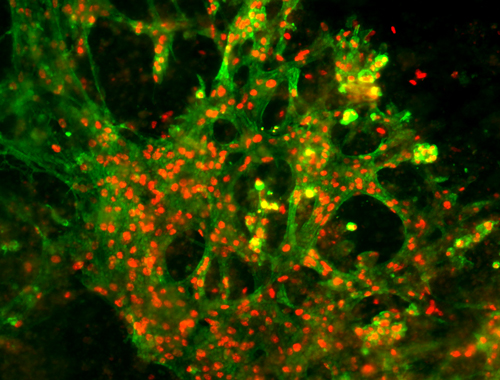3D Bioprinting for Hypoplastic Left Heart Syndrome
 Hypoplastic left heart syndrome, also known as HLHS, is the most common form of functional, single-ventricle heart disease, accounting for 7-9% of all congenital heart defects worldwide. Resulting in severe underdevelopment of the left side of the heart, HLHS renders the heart incapable of supporting systemic circulation and is responsible for 25 to 40% of all neonatal cardiac deaths when not including spontaneous or selective abortion as a result of the same. Current interventions—including fetal cardiac intervention, staged reconstructive surgery and cardiac transplantation—have improved substantially, but long-term survival rates are still largely dependent upon extensive surgical intervention, as well as the size and function of the right ventricle at the time of birth.
Hypoplastic left heart syndrome, also known as HLHS, is the most common form of functional, single-ventricle heart disease, accounting for 7-9% of all congenital heart defects worldwide. Resulting in severe underdevelopment of the left side of the heart, HLHS renders the heart incapable of supporting systemic circulation and is responsible for 25 to 40% of all neonatal cardiac deaths when not including spontaneous or selective abortion as a result of the same. Current interventions—including fetal cardiac intervention, staged reconstructive surgery and cardiac transplantation—have improved substantially, but long-term survival rates are still largely dependent upon extensive surgical intervention, as well as the size and function of the right ventricle at the time of birth.
In its ongoing efforts to develop next-generation solutions for cardiovascular care and using 3D Bioprinting Technology, the CaRE Lab is developing a model for producing bioengineered heart tissue more closely resembling that found in patients with HLHS. To do this, investigators will use human induced pluripotent stem cell-derived cardiomyocytes (iPSC-CMs) from both healthy individuals and patients with HLHS. By mimicking the growth environment of cardiomyocytes in vivo and performing 3D cell cultures of the bioengineered tissues, investigators will produce models more closely resembling naturally occurring HLHS heart tissue. Subsequent tissue analyses—including observing sarcomere structure, measuring tissue contractility and performing RNA extraction—will aid investigators in determining key differences between the cardiomyocytes found in patients with HLHS and healthy individuals, allowing biomedical engineers to begin looking towards additional non-surgical interventions designed to reduce suffering and prolong life in individuals suffering from HLHS.
Project Lead
 Aleks Zielonka
Aleks Zielonka
Aleks is currently seeking her Ph.D. in biomedical engineering with a focus on heart valve tissue engineering.
Related Publications
Wolfe JT, He W, Kim MS, Liang HL, Shradhanjali A, Jurkiewicz H, Freudinger BP, Greene AS, LaDisa JF Jr, Tayebi L, Mitchell ME, Tomita-Mitchell A, Tefft BJ. 3D-bioprinting of patient-derived cardiac tissue models for studying congenital heart disease. Front Cardiovasc Med. 2023;10:1162731 PMID: 37293290 PMCID: PMC10247285 SCOPUS ID: 2-s2.0-85161445064 06/09/2023
View more CaRE Research

 Hypoplastic left heart syndrome, also known as HLHS, is the most common form of functional, single-ventricle heart disease, accounting for 7-9% of all congenital heart defects worldwide. Resulting in severe underdevelopment of the left side of the heart, HLHS renders the heart incapable of supporting systemic circulation and is responsible for 25 to 40% of all neonatal cardiac deaths when not including spontaneous or selective abortion as a result of the same. Current interventions—including fetal cardiac intervention, staged reconstructive surgery and cardiac transplantation—have improved substantially, but long-term survival rates are still largely dependent upon extensive surgical intervention, as well as the size and function of the right ventricle at the time of birth.
Hypoplastic left heart syndrome, also known as HLHS, is the most common form of functional, single-ventricle heart disease, accounting for 7-9% of all congenital heart defects worldwide. Resulting in severe underdevelopment of the left side of the heart, HLHS renders the heart incapable of supporting systemic circulation and is responsible for 25 to 40% of all neonatal cardiac deaths when not including spontaneous or selective abortion as a result of the same. Current interventions—including fetal cardiac intervention, staged reconstructive surgery and cardiac transplantation—have improved substantially, but long-term survival rates are still largely dependent upon extensive surgical intervention, as well as the size and function of the right ventricle at the time of birth.  Aleks Zielonka
Aleks Zielonka 
